Riverside Travels in the Pays de la Loire
France’s longest river provides a wealth of scenic routes for enjoying this popular region. Stephen Davy-Osborne explores some of the highlights
Famed the world over for the sweeping vineyards and orchards that line the banks of its majestic river, it is no wonder that the Pays de la Loire is known affectionately as the ‘Garden of France’. The central north-western French region draws in huge numbers of visitors and is popular with Parisian holidaymakers and, of course, those of us from further afield. Venture against the current and you will find that the Pays de la Loire has more than a few other delights to enjoy.
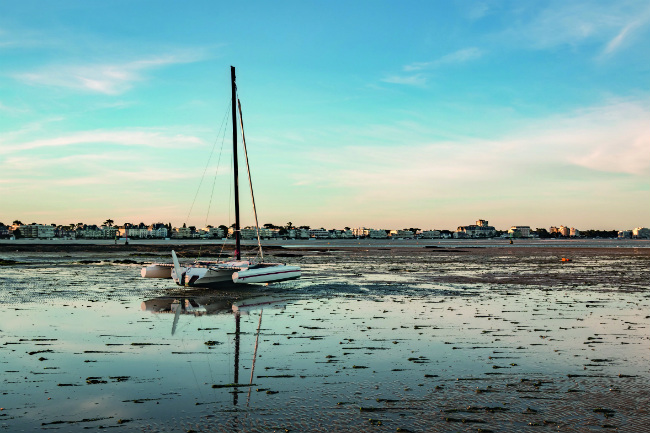
La Baule offers nine kilometres of sandy beaches. Photo: Fotolia
For an early diversion to your itinerary, set course for one of the Loire’s tributaries and travel northwards up the River Mayenne to Laval, capital of the Mayenne département. In Laval you will find not only the castle that has come to be a symbol of the city, the extensive remains of its medieval city walls, its historic half-timbered buildings and vestiges of the Gallo-Roman thermal baths that attracted visitors 2,000 years ago, but also a thriving arts scene that celebrates the work of Henri Rousseau, a native of the town, and a man recognised today as being one of the world’s leading naïve artists.
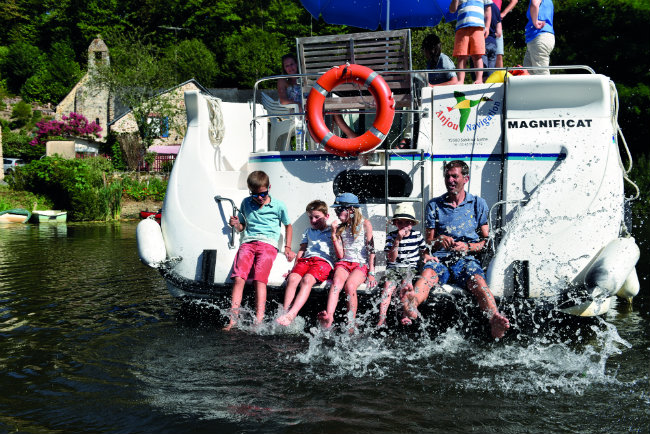
Anjou Navigation provides vessels for pleasure cruises along the riverways. Photo: Region Pays de la Loire
A SLOWER PACE
There is no more tranquil way to arrive in the city than to drift up-stream from Angers along the Mayenne River itself. Not only does this enable you to avoid the hustle and bustle of the roads but it allows you to enjoy life at a slower pace. Long since abandoned as a commercial shipping route, the Mayenne is now a popular waterway for pleasure seekers, many of whom will take a couple of days to explore the region from the river while living aboard one of Anjou Navigation’s spacious vessels. This really can be your home away from home for a couple of days as you cruise up the famous rivière.
By road, the town has always been a key point on the route between Brittany and Paris, and thanks in part to this, Laval grew in prominence as a producer of linen – though today it is perhaps more closely associated with butter and cheese, courtesy of dairy corporation Lactalis, which is based here.
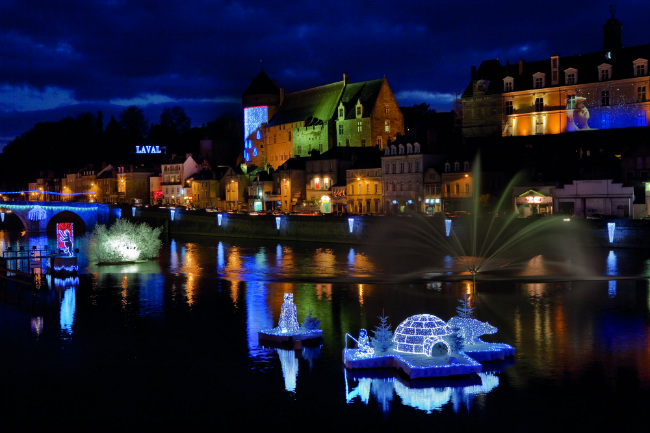
The town of Laval. Photo: Fotolia
In Laval you will find the largest museum in the world devoted solely to cheese and dairy production. La Cité du Lait Lactopôle is a collection of some 2,500 exhibits that detail the rise of the Groupe Lactalis from its humble beginnings as a small, local dairy in 1933 to a state-of-the-art multinational business that produces dairy products for people on five continents. Located within the company’s original site, next door to its current HQ, the museum takes you on a journey through that original dairy, faithfully recreated with authentic equipment, and the early days of producing the Camembert and butter that the business was founded on.

The Cité du Lait celebrates Laval’s prospering cheese industry. Photo: LACTOPÔLE
It also explores the importance of the dairy industry and the founding of Président cheese. The now iconic brand dates from a New Year’s party in 1968 when Michel Besnier declared that the family farm needed a classy label with strong symbolism. “France is the country of presidents – everyone is a president. From the fishing club to the bowling club and the war veterans,” he told his managers, who duly went away and returned four days later with the familiar brand of laurel leaves and crests of the three adjoining provinces that we see today.
ARTISTIC CREDENTIALS
As the birthplace of Henri Rousseau, it is no surprise that Laval also boasts some impressive artistic credentials that are really worth taking the time to explore, within the town’s medieval quarter and beyond. But venture out into the countryside and you will stumble across a unique garden of intrigue. It all began back in 1962 when artist Robert Tatin and his wife, Lise, bought a small farmhouse at La Frénouse in the commune of Cossé-le-Vivien. Tatin envisaged a monumental work surrounding this property that would celebrate civilisations and nature alike and become a bridge between East and West.

Robert Tatin’s Jardin des Méditations. Photo: MUSÉE ROBERT TATIN
Not long afterwards, the first sculptures of painted reinforced cement took shape in the gardens as the foundations were laid for L’Allée des Géants. Made up of 19 statues that retrace his own discovery of the world and his artistic career, Tatin’s avenue leads from the entrance of the museum down to the immersive Jardin des Méditations. Here, surrounding a tranquil pool, you will find 12 sculptures depicting the months of the year and a six-and-a-half-metre-high sculpture celebrating the link between Heaven and Earth named Notre-Dame-tout-le-Monde. Two decades of Tatin’s life were invested in these gardens, and his devotion has created an extraordinary collection of sculptures. The cottage where this dream was founded has been preserved in tribute to the artist, who died in 1983.

Robert Tatin’s Allée des Géants. Photo: MUSÉE ROBERT TATIN
MAKING DISCOVERIES
“You need to be able to live. You don’t learn a language for the sake of learning a language, you learn it to talk to people, to have fun, and to make discoveries.” These are the wise words of Thibault le Marié. At the beautiful Château de la Mazure, Thibault and his mother, Aude, have taken an innovative approach to teaching French to visitors to their stately home.
“How can you use language as a tool to do something with pleasure?” was the question Thibault faced before settling on the universal language of food. As a guest at the château, which has been in the family since 1900, you will find yourself taken downstairs to the kitchen to whip up a feast for the evening while also getting your tongue around the French language.
This is cultural immersion at its finest. The family have been cooking up a storm while improving the language skills of their guests. With a strong emphasis on becoming completely self-sustaining, Thibault has been exploring and implementing methods of making the château more environmentally friendly, to allow you to enjoy your home-cooked meal on the terrace with even greater peace of mind.

The Château de la Mazure, where you can learn French while you cook
“The goal of self-sufficiency is very important,” he says. “We want to become an example of that so people will come to the Mazure and see that it can be possible to be more in rhythm with nature.”
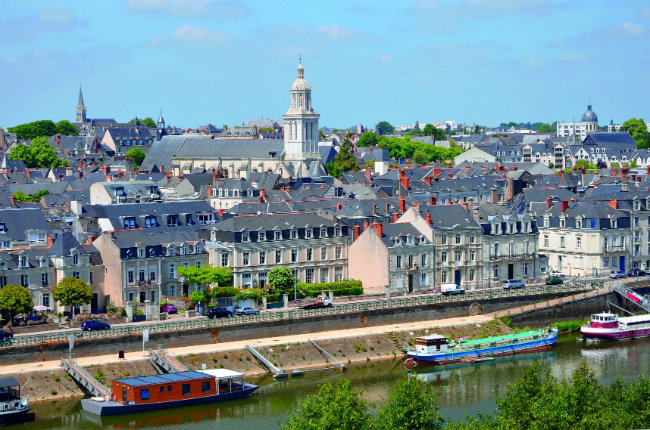
The medieval city of Angers lies on the River Maine, just north of where this tributary joins the Loire. Photo: Fotolia
Protected by 17 large shale and limestone towers, the Château d’Angers in the département of Maine-et-Loire is a magnificent sight to behold. Its perimeter walls stretch for 500 metres; its towers used to be 20 metres taller than they are today – they took on their current appearance in the late 16th century, after the advent of the cannon.
The Apocalypse Tapestry, for which the château is chiefly famous, depicts the story of the Book of Revelation. Commissioned by Louis I, Duke of Anjou, in 1375, much of it was lost during the Revolution, when it was cut up and fell into such diverse and profane use as winter insulation for fruit trees and horse stables. The section that remains is now preserved here. Outside in the gardens are a number of species of plants depicted in the tapestry.
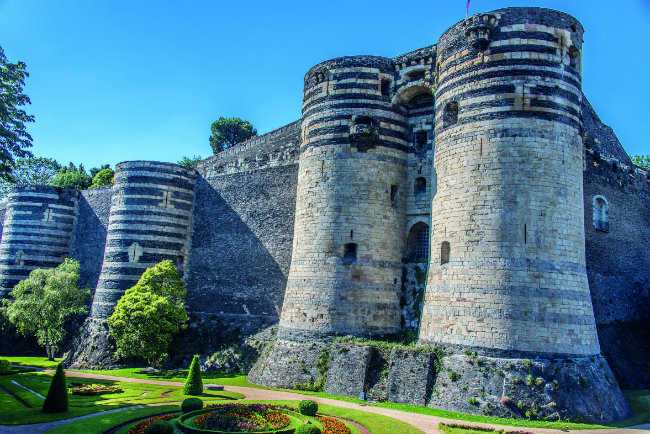
The Château d’Angers. Photo: Fotolia
OLD MEETS NEW
Continue west from here and you’ll come to the region’s capital, Nantes, with its imposing Château des ducs de Bretagne. Until 1941 this was the centre of the historical province of Brittany. Today, and now firmly within the Pays de la Loire, the château is a fusion of old meets new, with multimedia exhibitions depicting its colourful history through the ages.
The inland areas of the Pays de la Loire are only half the story though, with this region stretching out across the countryside right to the coast, where the River Loire meets the Atlantic in the Bay of Biscay. And it is here that many Parisians venture for some well-deserved peace and quiet to get away from it all, while enjoying one of the most picturesque coastlines France has to offer.
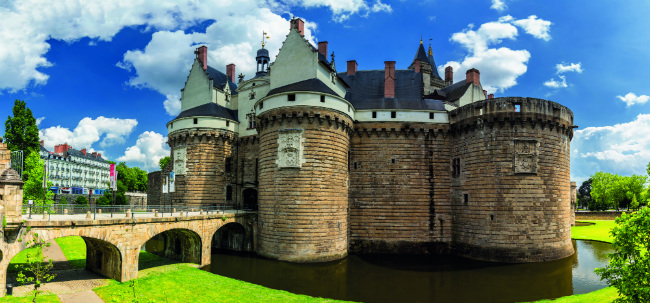
Nantes and its Château des Ducs de Bretagne. Photo: Fotolia
Just three hours from the capital by high-speed train, La Baule is a nine-kilometre stretch of sand and pure blue waters that has made itself a destination to be reckoned with – home to two of the world’s 18 luxury Barrière hotels and resorts. Beautifully ornate villas are nestled in among the pine trees set back from the golden sands of the beach, harking back to a golden era of days gone by, while harbours on either side of the bay highlight the popularity of sailing even to this day.
But the high-end seafront conceals a working-class heritage that is still very much at work today – and life really is black and white when it comes to this part of the Atlantic coastline. From humble beginnings amid peat miners, the nearby villages are now more commonly associated with salt. The Guérande salt pans stretch out along the countryside behind the seafront, and one of their effects is that sunlight casts beautiful patterns across the water.
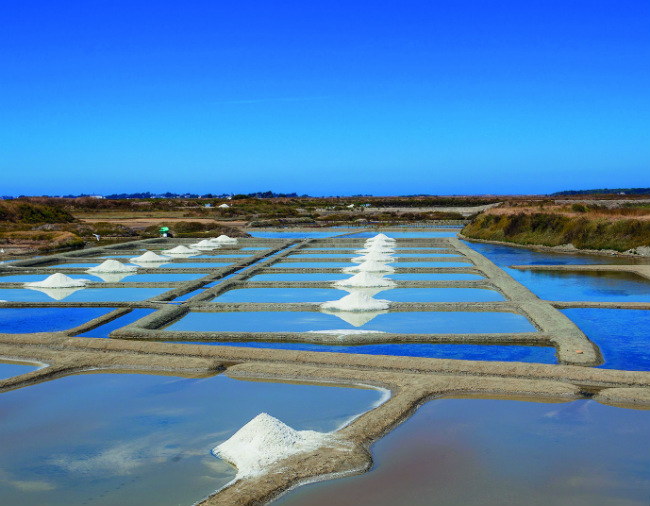
The salt marshes of Guérande. Photo: Fotolia
SALT MARSHES
The Guérande peninsula is home to some 2,000 hectares of salt marshes, and Guérande’s fleur de sel enjoys international fame and popularity. It is still farmed extensively today at the paludier village of Saillé. Records suggest that salt was being produced here as long ago as the 9th century AD, and the skills and experience have been passed down from generation to generation, resulting in some of the best salt in the world for flavour and mineral content. Pay a visit to La Maison des Paludiers to taste it for yourself – it doesn’t get much fresher than that.

Guérande’s fleur de sel. Photo: Region Pays de la Loire
Be sure also to pay a visit to the medieval walled town of Guérande itself. This is picture-postcard perfection, and home to delightful boutique shops, restaurants, coffee shops and crêperies, such as Crêperie Roc Maria, where you can enjoy classic sweet Bretagne crêpes or indulge in a savoury galette.
Heading south from here takes you across the awe-inspiring Saint-Nazaire bridge spanning the Loire. Continue along the coastline and you will come to the charming seaside town of Pornic. This picturesque fishing port – rather less well-known than affluent La Baule – is the perfect place to relax along the beautiful Jade Coast. Until the 1970s the harbour was a hive of activity for sardine fishers. Today, life passes by at a slower pace, and there is no better way of experiencing this than by enjoying some of the homemade ice creams and sorbets – or even freshly-picked strawberries – on offer at La Fraiseraie, while overlooking the harbour, now home to many pleasure craft. Be sure to try the sumptuous strawberry nectar before taking a stroll along the wooden walkway hugging the rugged harbour walls to the château.
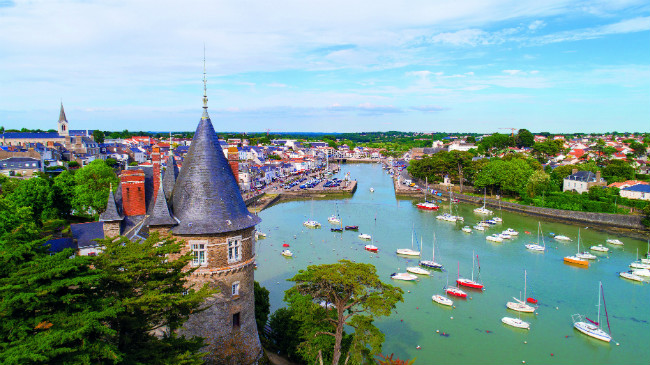
Pleasure craft in the harbour at Pornic. Photo: Fotolia
The banks of the Loire and its tributaries are a world unto their own, with a culture that is as rich and slow-flowing as the river itself. From the Brittany borderlands at Laval to the history of Angers and the modernity of Nantes, the atmosphere is quite unique and it’s not hard to see why so many Parisians like to come here to enjoy the fruits that the ‘Garden of France’ has to offer.
From France Today magazine
Share to: Facebook Twitter LinkedIn Email
Leave a reply
Your email address will not be published. Required fields are marked *

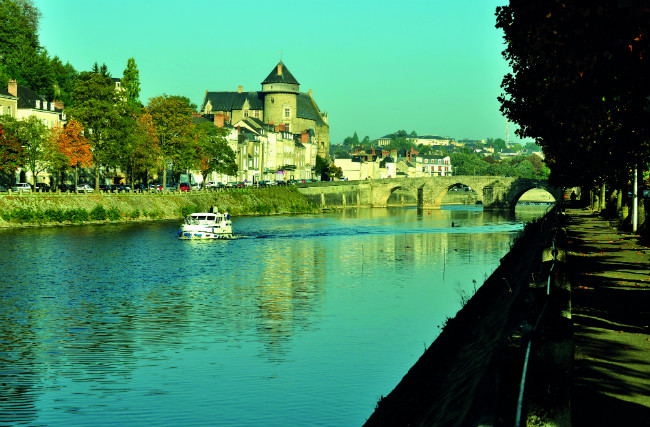




REPLY